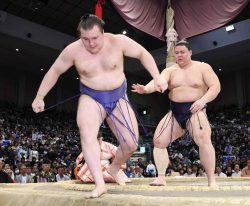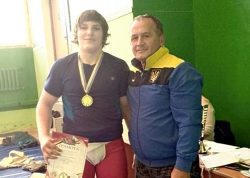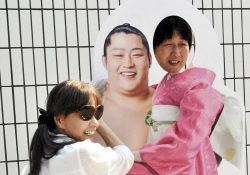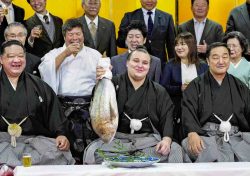
Attendants at a joint memorial service held in September 1963 gather in front of Chikarazuka and monuments honoring sumo reporters. Then Japan Sumo Association chairman Tokitsukaze, former yokozuna Futabayama, is seen in the front row, sixth from left.
12:30 JST, August 28, 2022
The Tokyo Sumo Sportswriters Club, a social organization for reporters covering the sport, was established on June 2, 1909, simultaneously with the opening of the orginal Ryogoku Kokugikan arena in Tokyo.
The club has a rich history over its 113 years. I heard that as early as five or six years prior to its formation, there was an organization called the Shinkaku-kai (association to promote sumo), in which newspaper reporters examined the results and performances of the wrestlers.
This year’s annual memorial service honoring reporters who passed away in the past year will be held on the seventh day of the Autumn Grand Sumo Tournament, which begins Sept. 11.
It is customary for former and current sumo reporters and officials of the Japan Sumo Association, among others, to gather at Ekoin temple in Tokyo’s Ryogoku to console the souls of the deceased reporters and others.
During the Edo period (1603-1867), a grand sumo tournament was held on the Ekoin temple grounds. Because of the deep historical links, there is a large stone monument on the premises called the “Chikarazuka” (Mound of Power), that pays homage to past stable masters and elders.
The Chikarazuka inscription in kanji characters on the monument was taken from the dynamic brushwork of Iesato Tokugawa, the 16th head of the Tokugawa clan.
If the Edo period had continued, Iesato would have been the 16th shogun.
The monument speaks volumes about the strong connection between sumo and the Tokugawa clan. Nearby, three monuments honoring sumo reporters humbly stand, for all intents and purposes, as if they were surrounding the Chikarazuka.
The first was built in May 1916, the second in September 1963 and the last in September 2008 by the Japan Sumo Association. The significance of the reporters’ monuments can be seen in the fact that the Chikarazuka was built in 1936, 20 years after the first monument for a reporter.
At the time when the Ryogoku Kokugikan sumo arena, then dubbed the “the leading sanctuary honoring combat sports in the East,” opened, the sport was at the height of its golden age in the Meiji era (1868-1912), with two yokozuna — Umegatani II and Hitachiyama — standing side by side.
The memorial service for the pioneer reporters began during this era, when the heavyweights of the sumo association paid tribute to the sport’s previous media members.
“It is really the power of the pen that has made sumo so prosperous,” they said.
The names of sumo reporters who died over the past year will be inscribed on the monument, and the chief priest of Ekoin will pray for their souls as he reads a sutra.
— Miki is a sumo expert.
"Sports" POPULAR ARTICLE
-

Speed Skater Yukino Yoshida Clinches Ticket to Milan
-

Yoshinobu Yamamoto Cheered by Los Angeles Lakers Fans at NBA Game
-

Kenta Maeda Joins Rakuten Eagles; Returns from American MLB to Japanese Pro Baseball for First Time Since 2015
-

Ukrainian Sumo Wrestler Sekiwake Aonishiki to be Promoted to Ozeki
-

Maruyama’s Ski Jump Streak Snapped
JN ACCESS RANKING
-

Keidanren Chairman Yoshinobu Tsutsui Visits Kashiwazaki-Kariwa Nuclear Power Plant; Inspects New Emergency Safety System
-

Tokyo Economic Security Forum to Hold Inaugural Meeting Amid Tense Global Environment
-

Imports of Rare Earths from China Facing Delays, May Be Caused by Deterioration of Japan-China Relations
-

University of Tokyo Professor Discusses Japanese Economic Security in Interview Ahead of Forum
-

Japan Pulls out of Vietnam Nuclear Project, Complicating Hanoi’s Power Plans
























